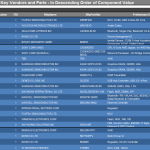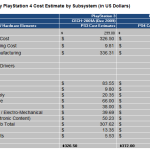In a breakdown of the PlayStation 4 hardware by analyst firm IHS, they have revealed that each console costs $372 to make when it comes to the bill of materials. This number increases to $381 when the manufacturing expense is added, but it’s still $18 less than the $399 Sony is charging for the system.
Of course, there are many other expenses associated with building every PS4, and Sony previously said how they were expecting to take a loss on the PS4, but would turn a profit sooner than they did with the PS3.
Delving deeper into IHS’s report, the PS4’s core processor and the associated graphic dynamic RAM come to $188, which is just over 50% of the console’s cost, as opposed to the 4th generation PS3 at 29%.
One area in which the price went up dramatically on PS4 was the DRAM, which is estimated to cost $88, while the 4th generation PS3 (CECH-2001A) was at just $9.80. Mike Howard, Senior Principal Analyst of DRAM and Memory at IHS, explained why the number is so much higher on PS4:
GDRAM DDR5 memory has much higher bandwidth than the DDR3 used in the Xbox One. It also works better with parallel computing and is designed specifically to enhance graphics performance. Because of its cutting-edge status, GDRAM GDDR5 is more expensive than DDR3, which is used in high volume in products including PCs and older game consoles.
Looking at ways Sony cut the cost of the PS4, the optical drive was just $28, down from the $66 for the 4th-gen PS3, due to the mechanism being largely unchanged since 2009. Another $10 was saved thanks to the more integrated design of the PS4, reducing the number of small-sized integrated circuits, discrete semiconductors, and passive components. All those devices cost $40 on PS4, as opposed to $50.23 on the 4th-gen PS3.
As well, with HDD costs declining in recent years, the PS4’s 500GB HDD is actually $1 cheaper than the 4th-gen PS4’s 120GB. And finally, $5 was saved in the mechanical portion of the design, including enclosures – like plastics and metals – and in the electro-mechanical content, such as printed circuit boards, connectors and wire harnesses.
Andrew Rassweiler, Senior Director of Cost Benchmarking Services at IHS, talked about the breakdown:
When Sony rolled out the original model of the PlayStation 3 in 2006, our teardown analysis revealed that the console delivered supercomputer-class performance at a price equivalent to a notebook PC. However, this achievement came with a major downside for Sony, as the BOM costs for most of the different versions of the console were in excess of the retail prices, in some cases by more than $100. Although Sony brought the PlayStation 3’s costs down significantly during its lifetime, the company’s intent was never to make money on the hardware, but rather to profit through sales of games and content.
Rassweiler added:
This time, Sony is on a greatly shortened path to the hardware break-even point, or even profitability, with its cost-conscious PlayStation 4 design. The company is pulling off this feat, despite offering a brand-new design that once again includes avant-garde components that yield superfast performance. The PlayStation 4 keeps a lid on costs by focusing all the additional expense on the processor and memory—and reducing outlays for the optical drive, the hard disk drive (HDD) and other subsystems.
To see exactly how much each component of the PS4 and 4th-gen PS3 costs, as well as a summary of the parts, check out these two tables:
Are you surprised by the cost of any of the PS4’s components? Let us know in the comments below.
[Via]
Essential Reading:










